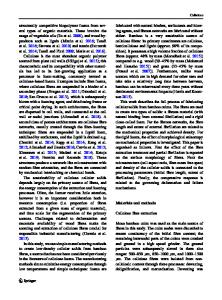The mechanical properties of bamboo and vascular bundles
- PDF / 532,577 Bytes
- 8 Pages / 584.957 x 782.986 pts Page_size
- 69 Downloads / 1,021 Views
gping Shena) State Key Laboratory for Strength and Vibration, School of Aerospace, Xi’an Jiaotong University, Shaanxi 710049, People’s Republic of China (Received 10 March 2011; accepted 29 August 2011)
Bamboo is a typical natural fiber-reinforced composite material with superior mechanical properties. As the reinforce phase in bamboo composite, the vascular bundles were extracted from different height locations of a Moso bamboo with an alkali treatment method, and the mechanical properties were investigated via the tensile test. It is found that both the longitudinal Young’s modulus and strength of the vascular bundles are linearly increased from the inner to outer side. To study the variation of mechanical properties of bamboo culm along the radial direction, thin bamboo slices were also tested. Using a modified rule of mixtures, the longitudinal Young’s modulus of bamboo slices are analyzed and excellent agreement can be found between experimental and theoretical results, which indicates that the longitudinal Young’s modulus of bamboo culm is cubically increased in the radial direction.
I. INTRODUCTION
With the increasing of worldwide societal awareness about environmental impact, sustainability and renewable energy sources, the green composites recently have attracted the attention of researchers due to the fact that they are recyclable and biodegradable. Natural fibers, such as flax, jute, sisal and bamboo, have been extensively used to produce environment-friendly composites in past years.1–5 Natural fibers have advantages over conventional reinforcement fibers in that they are cheap ($0.5/kg) with low density (1.2g/cm3) and excellent specific mechanical properties as listed in Table I, while conventional reinforcement fibers are nonrenewable, nonbiodegradable, and high-energy consumption in manufacturing process. For example, the cost of glass fiber is $3.25/kg, while carbon fiber can be as expensive as $200/kg.4 Among these plants, bamboo is a typical natural biological composite with superior mechanical strength and toughness. As one of the fastest growing plants, bamboo can grow at about 15–18 cm/day and reach its full height in 4–6 months.7 With these superior properties and other factors like low cost, rich natural resources, and environment-friendly service, bamboo stalks have been widely used in the construction of scaffolding, packing board, furniture panel, and especially for interior paneling in the automobile industry.2,4,5,8,9 a)
Address all correspondence to this author. e-mail: [email protected] DOI: 10.1557/jmr.2011.314 J. Mater. Res., Vol. 26, No. 21, Nov 14, 2011
http://journals.cambridge.org
Downloaded: 15 Feb 2015
The bamboo culm, as shown in Fig. 1(a), is an approximately cylindrical shell that is divided periodically by transversal diaphragms at nodes. Through millions of years evolution, bamboo has become a smart material with an optimized distribution of longitudinal fibers (i.e., vascular bundles) and biomatrices. In the transverse cross section of a bamboo culm [see Fig. 1(b)], it can
Data Loading...











